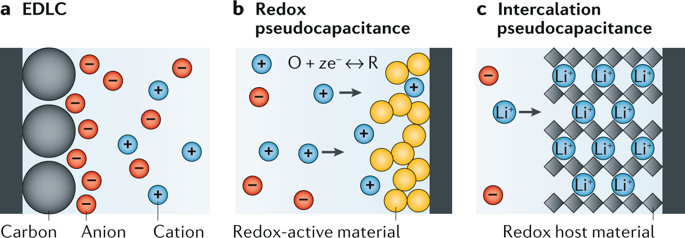Nature Reviews Materials ( IF 79.8 ) Pub Date : 2019-10-01 , DOI: 10.1038/s41578-019-0142-z Christopher Choi , David S. Ashby , Danielle M. Butts , Ryan H. DeBlock , Qiulong Wei , Jonathan Lau , Bruce Dunn

|
Batteries and supercapacitors serve as the basis for electrochemical energy-storage devices. Although both rely on electrochemical processes, their charge-storage mechanisms are dissimilar, giving rise to different energy and power densities. Pseudocapacitive materials store charge through battery-like redox reactions but at fast rates comparable to those of electrochemical double-layer capacitors; these materials, therefore, offer a pathway for achieving both high energy and high power densities. Materials that combine these properties are in demand for the realization of fast-charging electrochemical energy-storage devices capable of delivering high power for long periods of time. In this Review, we describe the fundamental electrochemical properties of pseudocapacitive materials, with emphasis on kinetic processes and distinctions between battery and pseudocapacitive materials. In addition, we discuss the various types of pseudocapacitive materials, highlighting the differences between intrinsic and extrinsic materials; assess device applications; and consider the future prospects for the field.
中文翻译:

使用伪电容材料实现高能量密度和高功率密度
电池和超级电容器是电化学储能设备的基础。尽管两者都依赖于电化学过程,但它们的电荷存储机制却不相同,从而导致不同的能量和功率密度。伪电容材料通过类似电池的氧化还原反应来存储电荷,但其速率可与电化学双层电容器媲美。因此,这些材料提供了实现高能量和高功率密度的途径。需要具有这些特性的材料,以实现能够长时间提供高功率的快速充电电化学储能装置。在这篇综述中,我们描述了假电容材料的基本电化学性能,着重于动力学过程以及电池和假电容材料之间的区别。此外,我们讨论了各种类型的伪电容材料,重点介绍了本征材料和非本征材料之间的区别;评估设备应用;并考虑该领域的未来前景。











































 京公网安备 11010802027423号
京公网安备 11010802027423号